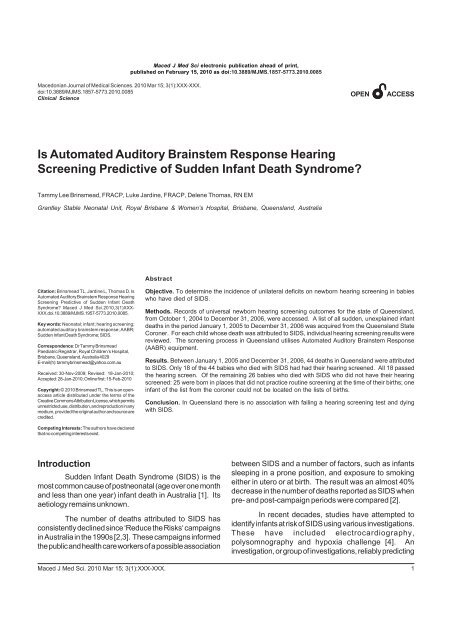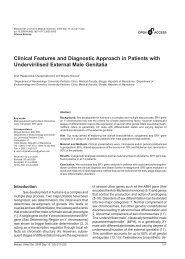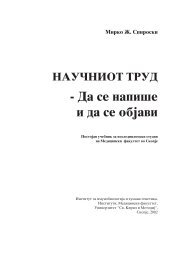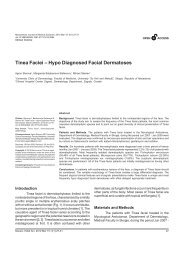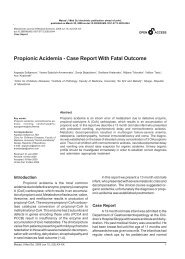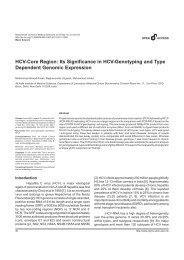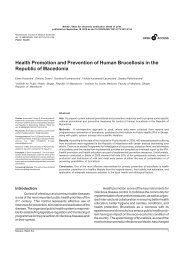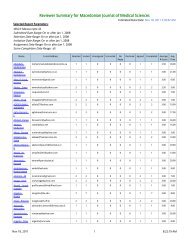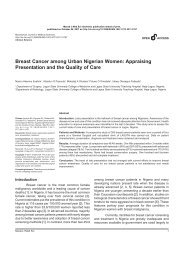Is Automated Auditory Brainstem Response Hearing Screening ...
Is Automated Auditory Brainstem Response Hearing Screening ...
Is Automated Auditory Brainstem Response Hearing Screening ...
You also want an ePaper? Increase the reach of your titles
YUMPU automatically turns print PDFs into web optimized ePapers that Google loves.
Maced J Med Sci electronic publication ahead of print,<br />
published on February 15, 2010 as doi:10.3889/MJMS.1857-5773.2010.0085<br />
Brinsmead TL. Sudden Infant Death Syndrome<br />
Macedonian Journal of Medical Sciences. 2010 Mar 15; 3(1):XXX-XXX.<br />
doi:10.3889/MJMS.1857-5773.2010.0085<br />
Clinical Science<br />
OPENACCESS<br />
<strong>Is</strong> <strong>Automated</strong> <strong>Auditory</strong> <strong>Brainstem</strong> <strong>Response</strong> <strong>Hearing</strong><br />
<strong>Screening</strong> Predictive of Sudden Infant Death Syndrome?<br />
Tammy Lee Brinsmead, FRACP, Luke Jardine, FRACP, Delene Thomas, RN EM<br />
Grantley Stable Neonatal Unit, Royal Brisbane & Women’s Hospital, Brisbane, Queensland, Australia<br />
Abstract<br />
Citation: Brinsmead TL, Jardine L, Thomas D. <strong>Is</strong><br />
<strong>Automated</strong> <strong>Auditory</strong> <strong>Brainstem</strong> <strong>Response</strong> <strong>Hearing</strong><br />
<strong>Screening</strong> Predictive of Sudden Infant Death<br />
Syndrome? Maced J Med Sci.2010,3(1)XXX-<br />
XXX,doi.10.3889/MJMS.1957-5773.2010.0085.<br />
Key words: Neonatal; infant; hearing screening;<br />
automated auditory brainstem response; AABR;<br />
Sudden Infant Death Syndrome; SIDS.<br />
Correspondence: Dr Tammy Brinsmead<br />
Paediatric Registrar, Royal Children’s Hospital,<br />
Brisbane, Queensland, Australia 4029<br />
E-mail (h): tammybrinsmead@yahoo.com.au<br />
Received: 30-Nov-2009; Revised: 18-Jan-2010;<br />
Accepted: 28-Jan-2010; Online first: 15-Feb-2010<br />
Copyright: © 2010 Brinsmead TL. This is an openaccess<br />
article distributed under the terms of the<br />
Creative Commons Attribution License, which permits<br />
unrestricted use, distribution, and reproduction in any<br />
medium, provided the original author and source are<br />
credited.<br />
Objective. To determine the incidence of unilateral deficits on newborn hearing screening in babies<br />
who have died of SIDS.<br />
Methods. Records of universal newborn hearing screening outcomes for the state of Queensland,<br />
from October 1, 2004 to December 31, 2006, were accessed. A list of all sudden, unexplained infant<br />
deaths in the period January 1, 2005 to December 31, 2006 was acquired from the Queensland State<br />
Coroner. For each child whose death was attributed to SIDS, individual hearing screening results were<br />
reviewed. The screening process in Queensland utilises <strong>Automated</strong> <strong>Auditory</strong> <strong>Brainstem</strong> <strong>Response</strong><br />
(AABR) equipment.<br />
Results. Between January 1, 2005 and December 31, 2006, 44 deaths in Queensland were attributed<br />
to SIDS. Only 18 of the 44 babies who died with SIDS had had their hearing screened. All 18 passed<br />
the hearing screen. Of the remaining 26 babies who died with SIDS who did not have their hearing<br />
screened: 25 were born in places that did not practice routine screening at the time of their births; one<br />
infant of the list from the coroner could not be located on the lists of births.<br />
Conclusion. In Queensland there is no association with failing a hearing screening test and dying<br />
with SIDS.<br />
Competing Interests: The authors have declared<br />
that no competing interests exist.<br />
Introduction<br />
Sudden Infant Death Syndrome (SIDS) is the<br />
most common cause of postneonatal (age over one month<br />
and less than one year) infant death in Australia [1]. Its<br />
aetiology remains unknown.<br />
The number of deaths attributed to SIDS has<br />
consistently declined since ‘Reduce the Risks‘ campaigns<br />
in Australia in the 1990s [2,3]. These campaigns informed<br />
the public and health care workers of a possible association<br />
Maced J Med Sci. 2010 Mar 15; 3(1):XXX-XXX.<br />
between SIDS and a number of factors, such as infants<br />
sleeping in a prone position, and exposure to smoking<br />
either in utero or at birth. The result was an almost 40%<br />
decrease in the number of deaths reported as SIDS when<br />
pre- and post-campaign periods were compared [2].<br />
In recent decades, studies have attempted to<br />
identify infants at risk of SIDS using various investigations.<br />
These have included electrocardiography,<br />
polysomnography and hypoxia challenge [4]. An<br />
investigation, or group of investigations, reliably predicting<br />
1
Clinical Science<br />
which infants are at risk of dying of SIDS has not been<br />
established [4].<br />
A recent report by Rubens et al., 2008 suggested<br />
an association between right sided unilateral hearing<br />
deficits as detected by newborn transient evoked<br />
otoacoustic emissions and the risk of SIDS [5]. Sininger<br />
et al., 2006 and Berninger, 2007 have previously reported<br />
larger amplitude waves on the right side on auditory<br />
brainstem response (ABR) testing in normal neonates<br />
[6,7]. An increased venous pressure effect on the right<br />
side causing disruption to the inner ear hair cells is a<br />
proposed mechanism for the unilateral difference [5].<br />
Stimulation of the vestibular system is known to cause a<br />
change in the respiratory pattern [8,9]. Vestibular stimulation<br />
can re-establish respiratory effort after apnoea [8-10]. An<br />
abnormality in respiratory control is a proposed mechanism<br />
for SIDS [5]. Inner ear insults can disrupt cochlear and<br />
vestibular function and it is possible that such an injury<br />
may occur in the perinatal period [5].<br />
The transient evoked otoacoustic emission<br />
technique described by Rubens et al [5] uses a small<br />
probe placed in the baby’s ear and the administration of a<br />
click stimulus at four frequencies in each ear (1500, 2000,<br />
3000 & 4000 decibels [dB]). A signal/noise ratio (SNR) is<br />
generated for each ear at each frequency. The SNR is the<br />
difference between the hearing measurement in decibels<br />
and the level of background noise. To have a pass then the<br />
following conditions need to be met:<br />
2<br />
1. SNR ≥ 4dB at 2,3 & 4 kilohertz;<br />
2. a click stimulus level between 74 dB and 86 dB;<br />
3. ≥ 50 sweeps of stimulus delivery in which the<br />
detected noise floor falls below the software’s<br />
predetermined acceptance/rejection level.<br />
The Royal Brisbane and Women’s Hospital has<br />
undertaken a universal newborn screening program<br />
(Healthy <strong>Hearing</strong>) since October 2004. This has gradually<br />
been established in other Queensland centres, and since<br />
December 2006 has been available to all birthing facilities<br />
in the state.<br />
Australia is a wealthy country, with generally high<br />
standards of medical care readily available. Its system of<br />
government has evolved from liberal democratic tradition,<br />
with influence from British and North American models<br />
[11]. Based on per capita gross domestic product, Australia<br />
ranks among the top twenty nations in the world [11]. Life<br />
expectancy for males and females is seventy-nine and<br />
eighty-four years respectively [11]. Queensland’s<br />
population, which represents 21% of Australia’s total, is<br />
estimated at 4.47 million [12]. 92% of the Australian<br />
population is Caucasian, Asians consistute 7%, and less<br />
the 1% is made up of Aboriginals (indigenous Australians)<br />
and other ethnic groups [13]. It is well known that health<br />
outcomes are consistently poorer in the indigenous<br />
population. Although Australia is an arid environment [14],<br />
88.6% of the population reside in urban areas [11], which<br />
are typically clustered around the more moderate, coastal<br />
regions.<br />
The aim of this study was to determine the<br />
incidence of unilateral deficits on newborn hearing screening<br />
in babies who have died of SIDS.<br />
Methods<br />
Records of universal newborn hearing screening<br />
outcomes for the state of Queensland, from October 2004<br />
to December 2006 inclusive, were accessed. A list of all<br />
sudden, unexplained infant deaths in the period January 1,<br />
2005 to December 31, 2006 inclusive was acquired from<br />
the Queensland State Coroner. For each child whose<br />
death was attributed to SIDS, individual hearing screening<br />
results were reviewed if available. To improve the likelihood<br />
of identifying hearing screening results on each baby,<br />
searches were conducted under the child’s surname at<br />
the time of death, and maternal surname at the time of<br />
birth.<br />
<strong>Hearing</strong> screening requires detecting the presence<br />
or absence of a response at a preset signal intensity level<br />
for the purpose of identifying which infants need further<br />
evaluation. The screening process in Queensland utilises<br />
<strong>Automated</strong> <strong>Auditory</strong> <strong>Brainstem</strong> <strong>Response</strong> (AABR)<br />
equipment. The goal of AABR is to detect the presence or<br />
absence of a signal, not estimate its characteristics [5].<br />
The screening equipment used by Queensland Health is<br />
the Natus ALGO 3® and the ALGO 3i® (Natus, San<br />
Carlo). One of the unique features of the ALGO® response<br />
detection method is the use of a binary signal detector.<br />
The equipment automatically records whether the baby<br />
has passed the screen (‘pass result’) or whether a referral<br />
for further screening (‘refer result’) is required. If a baby<br />
receives a ‘refer result’ on either or both ears a second<br />
screen of both ears is conducted at a later time to confirm<br />
the result. A ‘refer result’ does not necessarily mean that<br />
the baby has a hearing loss. Some common reasons for<br />
needing a second screen are: the baby was unsettled at<br />
the time of the first screen; there was background noise<br />
when the test was carried out and/or; the baby had fluid or<br />
a temporary blockage in their ear after birth. If the baby<br />
http://www.mjms.ukim.edu.mk
Brinsmead TL. Sudden Infant Death Syndrome<br />
receives a ‘refer result’ on either or both ears on the second<br />
screen the baby is referred for diagnostic audiology<br />
assessment.<br />
Statistical tests were done using GraphPad Prism<br />
version 3.02 for Windows (GraphPad Software, San Diego<br />
California USA, www.graphpad.com). To test for differences<br />
in proportions the Chi-squared test was used.<br />
Ethical approval was sought and granted by the<br />
Executive Director of Medical Services at the Royal<br />
Brisbane Hospital.<br />
Results<br />
From October 1, 2004 to December 31, 2006<br />
(inclusive), there were 117,029 births in Queensland [15].<br />
Of those, 75,161 births were in hospitals where babies<br />
could have their hearing screened [16]. 74,146 (ie.,<br />
63.36% of births and 97.79% of those born in hospitals<br />
that screen) of these babies actually underwent hearing<br />
screening. 1,015 of the 75,161 were not screened: 362<br />
were offered hearing screening but their parents or guardians<br />
declined, the reason the remaining 653 were not screened<br />
is unknown.<br />
Between January 1, 2005 and December 31,<br />
2006, 44 deaths in Queensland were attributed to SIDS<br />
[17]. Only 18 of the 44 babies who died with SIDS had had<br />
their hearing screened. All 18 passed the hearing screen.<br />
Of the remaining 26 babies who died with SIDS who did not<br />
have their hearing screened: 25 were born in places that<br />
did not practice routine screening at the time of their births<br />
[16]; one infant of the list from the coroner could not be<br />
located on the lists of births.<br />
The two by two table for failing the hearing screen<br />
by whether they died with SIDS or not is shown in Table<br />
1. The difference in proportions is not statistically significant<br />
(Chi-squared test, P value = 0.49).<br />
Table 1: Number of babies who passed hearing screening<br />
vs. failed hearing screening, and number of deaths attributed<br />
to Sudden Infant Death Syndrome.<br />
Two-sided Chi-squared test, P value = 0.4878.<br />
Maced J Med Sci. 2010 Mar 15; 3(1):XXX-XXX.<br />
Discussion<br />
None of the babies who died with SIDS failed to<br />
pass a hearing screening test and no baby that failed to<br />
pass a hearing screen died with SIDS. Therefore, using<br />
Queensland data, we have shown that there is no<br />
association with failing a hearing screening test and dying<br />
with SIDS. We have therefore failed to confirm the findings<br />
of Rubens et al., 2008 [5].<br />
This must be interpreted in context, however. The<br />
number of children who died with SIDS in our study was<br />
very small. In addition, only 41% of these deaths were in<br />
babies who had hearing screening, reducing the power of<br />
our study significantly.<br />
There are important differences between how<br />
Rubens et al screened hearing and our screening method.<br />
Otoacoustic emissions, as used in Rubens et al’s study<br />
[5] are obtained from the ear canal by using a sensitive<br />
microphone within a probe assembly that records cochlear<br />
responses to acoustic stimuli [18]. Thus, otoacoustic<br />
emissions reflect the status of the peripheral auditory<br />
system extending to the cochlear outer hair cells. In<br />
contrast, auditory brainstem response measurements are<br />
obtained from surface electrodes that record neural activity<br />
generated in the cochlea, auditory nerve, and brainstem in<br />
response to acoustic stimuli delivered via an earphone<br />
[18]. <strong>Automated</strong> auditory brainstem response<br />
measurements reflect the status of the peripheral auditory<br />
system, the eighth nerve, and the brainstem auditory<br />
pathway. Both otoacoustic emission and auditory brainstem<br />
response screening technologies can be used to detect<br />
sensory (cochlear) hearing loss; however, both<br />
technologies may be affected by outer or middle-ear<br />
dysfunction. Consequently, transient conditions of the<br />
outer and middle ear may result in a “failed” screening-test<br />
result in the presence of normal cochlear and/or neural<br />
function. Moreover, because otoacoustic emissions are<br />
generated within the cochlea, otoacoustic emissions<br />
technology cannot be used to detect neural (eighth nerve<br />
or auditory brainstem pathway) dysfunction. Thus, neural<br />
conduction disorders or auditory neuropathy/dyssynchrony<br />
without concomitant sensory dysfunction will not be<br />
detected by otoacoustic emissions testing [18].<br />
It is not uncommon for a newborn to fail hearing<br />
screens of this nature in the neonatal period. In an Italian<br />
study of 32,502 newborns in 13 regional birth centres,<br />
1.05% had an abnormal otoacoustic emissions result<br />
(156 children unilaterally, 179 bilaterally). Of those,<br />
however, 82.37% had a normal auditory brainstem response<br />
result [19]. Similarly, a Swedish study of 14,287 newborns<br />
3
Clinical Science<br />
at two maternity wards noted 1.35% of babies had a<br />
unilateral abnormality on otoacoustic emissions after two<br />
tests [20]. Families participating in neonatal hearing<br />
screening should be prepared for the possibility of false<br />
positives, and should be supported during the potentially<br />
anxious waiting period between screening and more<br />
definitive investigation.<br />
It is encouraging to note the high percentage of<br />
Queensland babies undergoing neonatal hearing screening<br />
tests. One of the limitations of this study, however, is that<br />
not all children identified as dying from SIDS in the time<br />
frame reviewed had hearing screening at birth.<br />
Our list of deaths attributed to SIDS is also likely<br />
to be incomplete. We were unable to account for children<br />
born in Queensland who may have died from SIDS interstate<br />
and internationally.<br />
It is interesting to note that a post hoc analysis of<br />
our data suggests a baby that does not have hearing<br />
screening is more likely to die of SIDS than a baby who has<br />
hearing screening – see Table 2. This association would<br />
need further exploration to draw any conclusions. It would<br />
be useful to establish if this trend has continued now that<br />
screening is universally available in Queensland.<br />
Table 2: Post hoc analysis of hearing screening vs no<br />
hearing screening and deaths attributed to Sudden Infant<br />
Death Syndrome.<br />
vulnerable to a Type I error [22].<br />
SIDS remains a complex and socially relevant<br />
area of study. There are vast opportunities for research,<br />
but the results must be filtered to the public with sensitivity<br />
and a sense of perspective. We would be wise to heed the<br />
advice of Krous and Byard, and Hamill and Lim. Highlighting<br />
the limitations of Rubens’ study, they remind us to protect<br />
families from misinterpreting its implications. First, we<br />
must prevent a sense of false reassurance in families with<br />
normal hearing screening results. An emphasis should<br />
remain on the principles of the Back to Sleep Campaign,<br />
the evidence for which is more reliable [21]. At the same<br />
time, we must prevent families being falsely alarmed if<br />
their baby fails a neonatal hearing screen [22]. The<br />
difference between the hearing results of those in Rubens’<br />
study who did, and did not, die of SIDS are subtle. This<br />
has further implications for anxiety in the context of an<br />
abnormal hearing screening test. In order to detect a<br />
majority (95%) of babies at risk of SIDS, an enormous<br />
number of false positives would occur (specifically, 87% of<br />
normal infants) if Rubens’ predictions are accurate [22].<br />
The fact that we found no association between<br />
failed hearing screening and SIDS, and given that in<br />
Queensland we use auditory brainstem response to screen<br />
hearing, means that Rubens et al’s results have little<br />
bearing or relevance in our population. Further study,<br />
involving a much larger number of subjects (particularly<br />
those dying with SIDS), is necessary to confirm the<br />
validity of this study’s findings.<br />
Two-sided Chi-squared test, P value = 0.0033.<br />
SIDS will always be a difficult area to research. It<br />
probably encompasses a range of causes, and once it<br />
occurs, further study is limited by the loss of the child’s<br />
life. Most observations must be made retrospectively.<br />
Critics caution that Rubens’ study [5] was<br />
retrospective, the number of SIDS cases small, and<br />
cochlear function was used as an unproven representative<br />
of vestibular function [21]. There is also a lack of clarity in<br />
the paper’s definition of SIDS, a common problem in this<br />
area of research [21]. In addition, the paper’s methods are<br />
controversial. Its use of matched controls, as compared<br />
to independent samples testing, makes it much more<br />
Conclusions<br />
This limited study suggests that in Queensland<br />
there is no association between failing a hearing screening<br />
test and dying with SIDS. Of the babies who died of SIDS<br />
between January 1, 2005 and January 2007, hearing<br />
screening was not predictive.<br />
References<br />
1. Australian Bureau of Statistics. SIDS in Australia 1981-<br />
2000 A Statistical Overview. 2003, August. p1. Accessed<br />
online (31/3/08). http://www.sidsandkids.org/researchstatistics.html<br />
2. Tursan d’Espaignet E, Bulsara M, Wolfenden L, Byard<br />
RW, Stanley FJ. Trends in sudden infant death syndrome in<br />
Australia from 1980 to 2002. Forensic Sci Med Pathol.<br />
2008;4(2):83-90. doi:10.1007/s12024-007-9011-y<br />
PMID:19291477.<br />
4<br />
http://www.mjms.ukim.edu.mk
Brinsmead TL. Sudden Infant Death Syndrome<br />
3. 3303.0 Causes of Death, Australia, 2006. pp 35-6.<br />
4. Bentele KH, Albani M. Are there tests predictive for<br />
prolonged apnoea and SIDS? A review of epidemiological<br />
and functional studies. Acta Paediatr Scand Suppl.<br />
1988;342:1-21. doi:10.1111/j.1651-2227.1988.tb10792.x<br />
PMID:3291551.<br />
5. Rubens DD, Vohr BR, Tucker R, O'Neil CA, Chung W.<br />
Newborn oto-acoustic emission hearing screening tests:<br />
preliminary evidence for a marker of susceptibility to SIDS.<br />
Early Hum Dev. 2008;84(4):225-9. doi:10.1016/<br />
j.earlhumdev.2007.06.001 PMID:17614220.<br />
6. Sininger YS, Cone-Wesson B. Lateral asymmetry in the<br />
ABR of neonates: evidence and mechanisms. Hear Res.<br />
2006;212(1-2):203-11. doi:10.1016/j.heares.2005.12.003<br />
PMID:16439078.<br />
7. Berninger E. Characteristics of normal newborn transientevoked<br />
otoacoustic emissions: ear asymmetries and sex<br />
effects. Int J Audiol. 2007;46(11):661-9. doi:10.1080/<br />
14992020701438797 PMID:17978948.<br />
8. Siniaia MS, Miller AD. Vestibular effects on upper airway<br />
musculature. Brain Research. 1996;736(1-2):160-4.<br />
doi:10.1016/0006-8993(96)00674-9 PMID:8930320.<br />
9. Mori RL, Bergsman AE, Holmes MJ, Yates BJ. Role of the<br />
medial medullary reticular formation in relaying vestibular<br />
signals to the diaphragm and abdominal muscles. Brain<br />
Research. 2001;902(1):82-91. doi:10.1016/S0006-<br />
8993(01)02370-8 PMID:11376597.<br />
10. Farrimond T. Sudden infant death syndrome and<br />
possible relation to vestibular function. Percept Mot Skills.<br />
1990;71(2):419-23. PMID:2251079.<br />
11. http://www.wpro.who.int/countries/2009/aus/ - accessed<br />
13 th January, 2010.<br />
12. http://www.oesr.gov.au – accessed 17 th January, 2010.<br />
13. CIA World Factbook. http://www.indexmundi.com/<br />
australia/ethnic_groups.html - accessed 17th January, 2010.<br />
14. http://www.bom.gov.au/lam/climate/levelthree/ausclim/<br />
ausclim.htm - accessed 17th January, 2010.<br />
15. Personal correspondence from the Department of Public<br />
Affairs, Queensland State Office.<br />
16. Queensland Health, Healthy <strong>Hearing</strong> Program Hospital<br />
Databases. Electronic record of universal newborn hearing<br />
screening outcomes in Queensland, public and private<br />
birthing facilities.<br />
17. Personal correspondence from the Queensland Office<br />
of the State Coroner.<br />
18. <strong>Hearing</strong> JCoI. Year 2007 Position Statement: Principles<br />
and Guidelines for Early <strong>Hearing</strong> Detection and Intervention<br />
Programs. Pediatrics. 2007;120:898-921. doi:10.1542/<br />
peds.2007-2333 PMID:17908777.<br />
19. Calevo MG, Mezzano P, Zullino E, Padovani P, Serra G,<br />
STERN Group. Ligurian experience on neonatal hearing<br />
screening: clinical and epidemiological aspects. Acta<br />
Paediatr. 2007;96(11):1592-9. doi:10.1111/j.1651-<br />
2227.2007.00475.x PMID:17937684.<br />
20. Hergils L. Analysis of measurements from the first<br />
Swedish universal neonatal hearing screening program.<br />
Int J Audiol. 2007;46(11):680-5. doi:10.1080/<br />
14992020701459868 PMID:17978950.<br />
21. Krous HF, Byard RW. Newborn hearing screens and<br />
SIDS. Early Hum Dev. 2008;84(6):371. doi:10.1016/<br />
j.earlhumdev.2007.10.003 PMID:17996406.<br />
22. Hamill T, Lim G. Otoacoustic emissions does not<br />
currently have ability to detect SIDS. Early Hum Dev.<br />
2008;84(6):373. doi:10.1016/j.earlhumdev.2007.10.004<br />
PMID:18096330.<br />
Maced J Med Sci. 2010 Mar 15; 3(1):XXX-XXX.<br />
5


